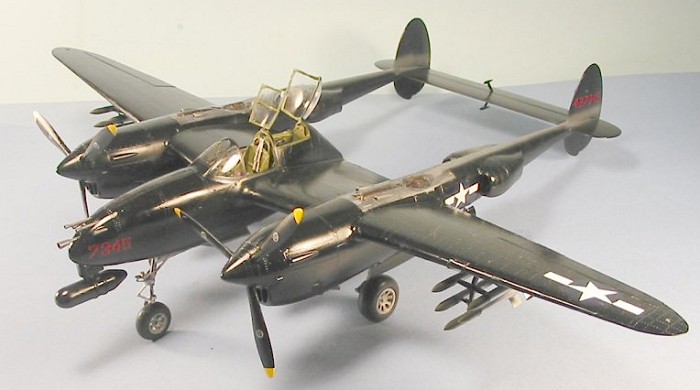
| KIT #: | ? |
| PRICE: | $124.95 MSRP |
| DECALS: | See review |
| REVIEWER: | Tom Cleaver |
| NOTES: | Jerry Rutman P-38M conversion set utilized ($45.00) |

| HISTORY |
The radar-equipped night fighter was one of the outstanding developments of combat aviation in the Second World War. Originally designed for defense against attacking bombers, by 1944 the Royal Air Force was using both Beaufighter and Mosquito night fighters as escorts to Bomber Command’s Main Force to defend the Lancasters and Halifaxes from Luftwaffe Bf-100G, Ju-88G and He-219 night fighters with enough success that crews of the Nachjagdwaffe had a term for their feelings of dread whenever their radar receivers picked up the radar emissions of British night fighters searching for them: Moskitopanik.
American bomber units had operated primarily by day until General Curtis LeMay directed the B-29s of the 20th Air Force to attack Japanese cities by night. While the Japanese were nowhere near as advanced in the use of radar as were the Germans or the Allies, the brightly-lit skies over burning Japanese cities gave those Japanese pilots who chose to oppose the B-29s by night conditions that allowed for visual interception of the bombers, which carried only tail armament in the quest to maximize bomb load. The USAAF had the Northrop P-61 “Black Widow” available, but the war’s only designed-for-the-purpose night fighter was at a disadvantage going after Japanese day interceptors.
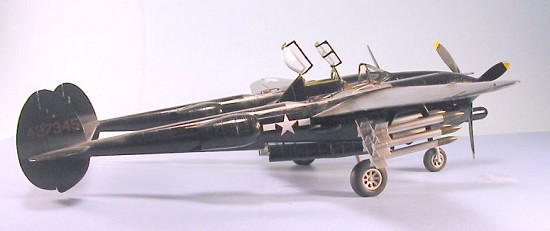 What was needed
was a night fighter with the performance of a day fighter and the range to
escort the bombers over Japan. With the capture of Okinawa imminent, it
would be possible to base these fighters on that island, so they would not
have to fly the long over water missions performed by P-51s based on Iwo
Jima.
What was needed
was a night fighter with the performance of a day fighter and the range to
escort the bombers over Japan. With the capture of Okinawa imminent, it
would be possible to base these fighters on that island, so they would not
have to fly the long over water missions performed by P-51s based on Iwo
Jima.
The P-38 Lightning had demonstrated its superiority over nearly every Japanese fighter then in use. The big twin had the space necessary for a small radar installation and the radar operator, as a fairly-easy modification. Lockheed took P-38L-5-LO 44-25237 from the Burbank production line and modified it at the Fresno Modification Center with a “piggy back” cockpit into which a small radar operator could squeeze behind the pilot, under a “blister” canopy over the course of a few weeks. The lightweight AN/ASH radar was mounted beneath the nose on a bomb rack. Flight tests established that the extra weight of the radar operator and radar had only a very slight effect on the P-38's performance.
The Air Force determined they only needed one group of these night fighters, for use during the upcoming invasion of the Japanese homeland. 75 P-38L-5-LO Lightnings were taken at random from the Burbank factory and flown to the Fresno Modification Center where they were modified to P-38M-6-LO configuration.
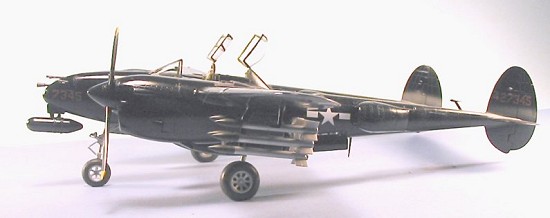 The 75
night-fighting P-38s had been delivered by late July, and the 484th
Night Fighter Group was working up on them at Fresno when the war came to
an end on August 15, 1945. Contrary to some post-war legends, none of
these aircraft ever saw operational service during the war, and they were
all out of the Air Force inventory by the Spring of 1946. As these
airplanes were among the airframes with the lowest number of flight hours
on them, they were snapped up in the post-war surplus market, where they
were then modified to F-5G configuration for use during the nest 20 years
for photogrammetric work around the world. Eventually only one was left,
and it was modified back to P-38L single-seat configuration by Doug
Champlin when he acquired the aircraft for his museum collection in the
mid-1970s. This airplane is among the Champlin Fighter Museum aircraft
transferred to the Seattle Museum of Flight in the past year.
The 75
night-fighting P-38s had been delivered by late July, and the 484th
Night Fighter Group was working up on them at Fresno when the war came to
an end on August 15, 1945. Contrary to some post-war legends, none of
these aircraft ever saw operational service during the war, and they were
all out of the Air Force inventory by the Spring of 1946. As these
airplanes were among the airframes with the lowest number of flight hours
on them, they were snapped up in the post-war surplus market, where they
were then modified to F-5G configuration for use during the nest 20 years
for photogrammetric work around the world. Eventually only one was left,
and it was modified back to P-38L single-seat configuration by Doug
Champlin when he acquired the aircraft for his museum collection in the
mid-1970s. This airplane is among the Champlin Fighter Museum aircraft
transferred to the Seattle Museum of Flight in the past year.
| THE KIT |
For a look at what is in the Trumpeter kit, please visit the preview .
Jerry Rutman, who has previously brought out resin conversion sets for the P-38F/G/H and the F-5A and F-5E photo-recon Lightnings for use with the outstanding Trumpeter kit, has recently completed this conversion set for the P-38M which includes the radar installation, flash suppressors for the 4 machine guns and one 20mm cannon, and a fully-detailed resin “piggy back” cockpit. The set is designed to be used with his resin corrected cockpit, corrected prop blades, and landing gear.
| CONSTRUCTION |
As regards basic construction of the kit, I will refer you to my review of the Trumpeter P-38L kit and confine my review here to the work necessary to convert the kit to the P-38M with the Rutman conversion set.
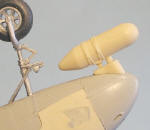 When Jerry sent me the kit and conversion set to use for this review, there
were parts missing such as the nose wheel leg and gun bay doors, which he
had used to create parts for the other conversion sets. Thus, I used resin
gun bay doors from the F-5A set, and the new white metal nose wheel leg.
If you decide to do this version, you will use the standard kit gun bay
doors and nose wheel leg (unless you opt to buy Jerry’s separately). I
also used the kit propellers without modification;
When Jerry sent me the kit and conversion set to use for this review, there
were parts missing such as the nose wheel leg and gun bay doors, which he
had used to create parts for the other conversion sets. Thus, I used resin
gun bay doors from the F-5A set, and the new white metal nose wheel leg.
If you decide to do this version, you will use the standard kit gun bay
doors and nose wheel leg (unless you opt to buy Jerry’s separately). I
also used the kit propellers without modification;
 these
are a scale two feet too short, which is noticeable if I place the
completed kit next to my P-38H and P-38L, which used Jerry’s corrected
props. I also used the kit cockpit other than a resin replacement seat.
these
are a scale two feet too short, which is noticeable if I place the
completed kit next to my P-38H and P-38L, which used Jerry’s corrected
props. I also used the kit cockpit other than a resin replacement seat.
The first thing to do is to cut off the rear area of the central nacelle
behind the cockpit, and fit the resin “piggy back” cockpit here. It is
interesting to note that this cockpit did not have a seat - the operator
knelt on the canvas floor. The set includes the radar receiver and various
“black boxes” for the side walls, and an armor plate for the rear
bulkhead. I did not fit the vacuformed canopy until I had otherwise
finished the model - if you want that canopy closed you should fit it
during construction and fill the ensuing gaps to get a clean fit. Since I
didn’t want to wreck the paint scheme, I attached the canopy
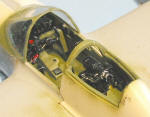 in
the open position.
in
the open position.
Once the rear cockpit is in position and the gap around it is filled and all is smooth, the model assembles as per the standard kit, other than to fit the radome on the lower nose. The antenna that is there on all other P-38s should be relocated to the left boom, just behind the main gear wheel well.
I made no attempt to fit the guns in the nose, since I filled that area with weight to get a nose-sit on this heavy model. I cut off the gun barrels, fitted the resin flash suppressors, and attached these after the model was otherwise finished.
| COLORS & MARKINGS |
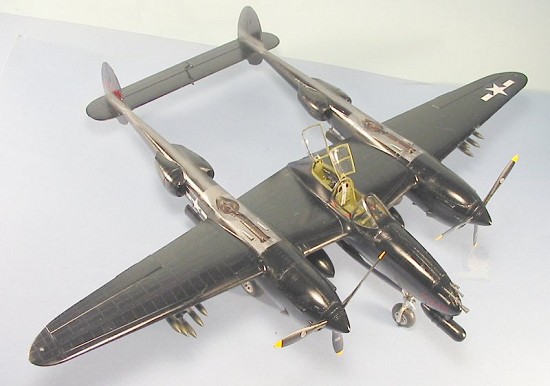 The landing
gear, wheel wells and inner gear doors were painted with aluminum lacquer
on P-38Ls, and this was not changed for the P-38Ms, which were otherwise
painted an overall glossy black other than the area around the turbo
chargers. I painted the model with Tamiya X-18 Semi-gloss Black, and then
Futured it when the paint was dry. I had previously painted the area
around the turbo exhausts and the exhausts with Metalizer paints, and
masked those off before painting the rest of the model.
The landing
gear, wheel wells and inner gear doors were painted with aluminum lacquer
on P-38Ls, and this was not changed for the P-38Ms, which were otherwise
painted an overall glossy black other than the area around the turbo
chargers. I painted the model with Tamiya X-18 Semi-gloss Black, and then
Futured it when the paint was dry. I had previously painted the area
around the turbo exhausts and the exhausts with Metalizer paints, and
masked those off before painting the rest of the model.
There are no markings available for the P-38M in 1/32 scale. Some of these airplanes carried nose art, but otherwise the only markings were the serial number on the outer rudders in gloss red, with the last four numbers of the serial repeated on the nose, and the standard national insignia. There are some rumors that all the stenciling was re-done in red, but I’ve never seen a photo that could prove that. This was a special unit with experienced personnel assigned who would have known what went where, and time was of the essence in getting them ready for war, so my educated guess is that they did not have stenciling. I used the kit national insignia decals, and red numbers from an old decal sheet in the decal dungeon. I did use the kit decals for the markings and yellow tips of the prop blades.
| FINAL CONSTRUCTION |
I gave the model another coat of Future, then three coats of Testor’s Dullcote to bring the gloss level down to something that looked more realistically less-glossy. I applied exhaust staining with thinned Tamiya Dark Grey paint. I then attached the two canopy lids and the model was finished.
| CONCLUSIONS |
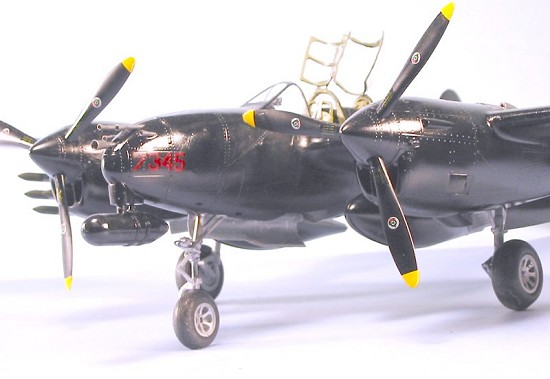 The Trumpeter
P-38 looks impressive when finished whether out of the box or modified to
early version, night fighter or photo-recon variants. If I was doing this
model for my own collection (it’s out at Planes of Fame Air Museum as you
read this) I would spring for the better-looking resin cockpit, the white
metal nose wheel leg which lifts the nose enough to give it that nose-high
“P-38 stance,” the corrected prop blades, and the resin tires. As regards
decals, one could scan the Aeromaster P-38M decals to get nose art, enlarge
it in the computer and print it with an ALPS, to add to the final look of
the model. You’ll definitely get a second look if you put this model on
public display.
The Trumpeter
P-38 looks impressive when finished whether out of the box or modified to
early version, night fighter or photo-recon variants. If I was doing this
model for my own collection (it’s out at Planes of Fame Air Museum as you
read this) I would spring for the better-looking resin cockpit, the white
metal nose wheel leg which lifts the nose enough to give it that nose-high
“P-38 stance,” the corrected prop blades, and the resin tires. As regards
decals, one could scan the Aeromaster P-38M decals to get nose art, enlarge
it in the computer and print it with an ALPS, to add to the final look of
the model. You’ll definitely get a second look if you put this model on
public display.
November 2004
Copyright ModelingMadness.com
Thanks to Jerry Rutman for the kit and conversion set. Get your sets from him directly - they’re worth the extra cost. Contact him at jrutman@ptd.net for prices and availability
If you would like your product reviewed fairly and fairly quickly, please contact the editor or see other details in the Note to Contributors.